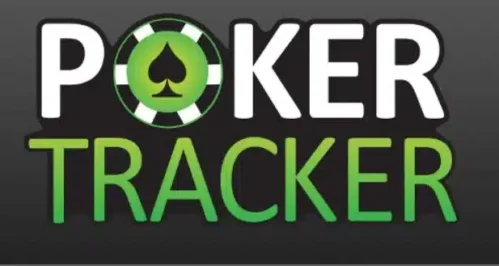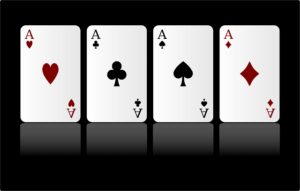- Updated: January, 2024
- Bartek
Poker tells are one of my favorite parts of this complex game. Finding them can give you enormous satisfaction and some extra winnings.
Before we talk about the best books that can improve your tells game, let’s answer a few questions to better understand this vital part of poker.
If you want to go straight to the books, you can use the below button or table of contests.
Table of Contents
My favorite poker tool
⇒ Display info about opponents while playing (HUD)
⇒ Analyze your poker sessions
⇒ Find your leaks
What are poker tells?
Poker tell is a verbal or physical action that gives off clues about the strength of a player’s hand.

What are the most common tells?
the standard tells include:
Body language:
- nervous lips,
- micro lips expressions,
- heartbeat etc.
Betting patterns:
- bet size (how much you bet),
- timing (how fast you bet),
- the way you place a bet (i.e., throwing chips).
Card Protectors + Miscellaneous Items:
- for example, how you place your card protector and where you place it.
Chip stacking:
- includes stacking chips in a tidy pile (a sign of tight play)
- or spreading chips around the table (a sign of stress).
Verbal:
- for example, being happy/positive (a sign of a good hand in amateur players)
- or cursing and being mean (a sign of tilt).
How to spot poker tells?
The best way to spot poker tells is to constantly pay attention to your opponents and try to find patterns in their behavior.
You must observe other players not only when you are involved in a hand but also after you fold your hand.
This is one of the biggest mistakes amateur players make. Instead of getting free information by watching other players at the table, they play with their smartphones and do other things unrelated to the game.
You are lucky if you have a guy like this at your poker table! In case there are more of those players at your table, you are in an aquarium full of fish.
How can poker tells influence your game?
Finding them in opponents and not giving off yours can be a significant factor in the size of your winnings.
While some players are more skillful at hiding their tells, others may be more exposed to giving them off.
Paying attention to tells can help you get an edge over your rivals and enhance your odds of winning.
Can you read tells in online games?
There are tells in online poker, but they aren’t as many as in live games. For example, there are no verbal or physical tells in online games.
Also, online tells are much more difficult to spot than live tells.
Because players are not physically present, they can more easily disguise their tells. Nevertheless, there are still online poker tells that can be noticed:
- The time your opponent takes to bet
- The amount she/he bets
- Chatbox activity
- Board action/playing patterns
I have found some good tells in many online tournament players. I probably shouldn’t be revealing that 🙂
Anyways, here it is:
- Players who call quickly on drawing boards have a hand that is incomplete and needs additional cards to become useful (i.e., flash/straight draw)
- Players who take a long time for a simple decision or sit out often in online games probably don’t pay enough attention to the game because they are busy with something else.
- Players who are harsh on chat are probably tilted and can play loose.
- Instant checking – this action tells you that the player has used the “Check/Fold” pre-action button. Most of the time, this means a weak hand from a player with no patience who wants to move to the next hand.
How to stop giving off your poker tells in live and online games?
They can be verbal or nonverbal and occur consciously or subconsciously in live or online games.
The best way to stop giving off your poker tells is to be aware and try to control them.
If you have trouble controlling your tells, many resources can help you, including books, articles, and videos.
The main ways to stop giving off poker tells include:
- LIVE TELLS
- ONLINE TELLS
- Don't talk during hands
- Have a set base position that you go back to every time
- Look at your cards only once
- Change your betting pattern
- Mix up your ranges
- Don't show your cards
- Look at your cards before your turn to act
- Watch your legs. Make sure you don't move them
- Take a second before any action
- Try not to play with your chips
- Leave the cards face down on the felt. Don't hold them
- Don't use card protectors. If you have to, always use them in the same way
- Overall, try to be stoic.
- Don't use the chatbox during hands
- Try to place your bets always after the same amount of time
- Don't use the automatic check/fold action button
- Change your betting pattern and bet sizes
- Don't show your cards
- Mix up your ranges
One more thing. Bookokpoker is an independent blog. I don’t get paid for it.
So, if you decide to buy any of the books, please do it via the below links. This way, I will get a tiny commission from Amazon (between 4-5% of the price) at no extra cost to you. It will help me to create more valuable content for you. Thank you!
Top 7 books on poker tells
- Cool, old pictures.
- A detailed description of tells.
- Includes quizzes to test your tells knowledge.
- Great examples.
- Easy to understand.
- A little bit outdated.
- Not for online games.
This is one of the most-known poker books.
Mike Caro’s Book is divided into two main sections:
1. Acting Tells – from actors
2. Natural Tells – from unaware players
- Includes physiology and psychology of tells
- Little poker jargon
- Easy to read
- Short and to-the-point
- Ideas are presented in a very clear manner
- Minimal contributions from Phil
- Repetitive
Navarro’s tell characterizations reveal the context of manners at the table. If you have problems effectively reading players, get this book.
FBI interrogator in poker
It’s amazing to have a former FBI interrogator providing information on when players are bluffing or telling the truth.
Navarro is one of the founders of the FBI’s BAP (Behavioral Analysis Program). He was also part of the SWAT Team.
What can you learn from it?
Phil Hellmuth Presents Read’ Em and Reap is short and to the point. It examines critical neurological responses and honest tells.
In contrast to the “weak means strong” principle of the main tells in other books, this one trains you to see frequently subtle but nearly always honest indicators of confidence at a particular moment in a game.
The authors teach you to read opponents’ tells and be mindful of not giving off tells yourself.
Who is it for?
There is not much poker jargon in this book, making it valuable for a novice. Additionally, Navarro’s views are presented in a very straightforward manner.
What didn’t I like?
The negatives of this book include too much of Hellmuth’s ego and the fact that he didn’t write the book; it’s all Joe.
Nevertheless, the material is presented well and it will help you to move your game to the next level.
- cheap
- good analysis of tells
- for beginners
- the e-book has no photos
- not very detailed
Joe Navarro shows us an easy-to-follow guide to 200 of the most observed tells in poker.
200 Poker Tells is a follow-up to the previous book – Read ’em and Reap.
A remarkable thing about this book is that the tells are split into body parts.
The e-book has no photos on the negative side, and much of the information was already included in the previous book, Read ’em and Reap.
Also, the description of the tells is not very detailed.
Recommendation
If you want a short description of many poker tells, then this book is for you. I can recommend it to novice players.
- well structured
- tons of pictures with examples
- short and easy to digest
- well written
- useful tips
- based on thousands of hours of play
- the about section should be located at the beginning of the book
- a bit repetitive
Zachary Elwood has written three poker books on tells:
1) Reading Poker Tells
All of them are included in this ranking. I would advise you to read them in the above order to understand this topic better.
Zachary was a poker tells coach for two players that were at the WSOP final table. His articles have been featured in NY Times, Buzzfeed, and Washington Post,
The book is divided into three sections:
- Waiting-for-Action tells.
- During-Action tells.
- Post-Bet tells.
For each section, Zachary lists the tells players tend to reveal when they are either weak or strong.
He includes excellent knowledge of how to carry yourself at the poker table and fantastic info on how to notice bluffers.
The information shown in Reading Poker Tells is very approachable. The explanations are clear and easy to understand.
Focusing on the specific situation is very useful because sometimes tells give away contradicting messages.
The personal information section located at the end of the book should be at the beginning. I think it’s better to read this section first to get a good insight into the author’s credibility.
There are many free videos on YouTube that Elwood creates.
I advise watching these alongside the book, as the visual character of tells can be challenging to explain in writing. Seeing them in the videos will make it easier for you to comprehend.
- well-written, comprehensive
- meticulously researched
- clear explanations
- lots of examples
- the layout and print quality are flawless
- None found
Elwood is genuine and thoughtful in Verbal Poker Tells. He is honest in explaining the accuracy and usefulness of tells in specific situations.
What’s inside the book?
The book describes the most typical and trustworthy verbal patterns poker players have.
You will learn a framework for thinking about verbal behavior at the poker table.
Elwood includes numerous real poker hands from well-known poker games:
- World Series of Poker
- Poker After Dark
- High Stakes Poker
An honest author describes it as it is
Elwood is modest in his writing style and supplies the knowledge without the look-at-me attitude.
‘I’ve tried to establish a behavioral baseline that will, more often than not, be reliable. I don’t pretend that the patterns in this book are universal, one-size-fits-all patterns. But if I’ve accomplished my goal, the patterns in this book will be reliable for recreational poker players more often than they’re not reliable.”
Recommendation
While this book alone won’t make you a poker champ, it certainly will move your game to the next level. I can recommend it to all players (amateurs and pros).
There are not many books to handle verbal tells in such detail. This book is meticulously analyzed with tons of examples. The structure and print quality are flawless.
The Audio version of the book is perfect.
- easy to read
- easy to comprehend, and to implement
- the best of the trilogy
- well organized
- none found
This book is the last one in Zachary Elwood’s trilogy.
Exploiting Poker Tells concentrates on practical, real-world concerns, answering multiple questions:
- ‘What manners are essential to pay attention to when making a decision?’
- ‘When significant poker reads are made, what elements are involved?’
- ‘What behaviors can be ignored and why?’
Interviews, quizzes, and hand examples
There are 130+ detailed hand histories in this book. The author also included tell interviews with pro poker players and quizzes to test your knowledge.
Like the other two books of this trilogy, this one is easy to read, comprehend and implement. It is well organized based on the street of the hand.
Recommendation
If you want real-life samples and techniques for implementing poker tells into your game, this book and the entire trilogy are the places to go!
Exploiting Poker Tells is probably the best of the trilogy. Although, for best results, I recommend reading all three books.
- well written
- easy to understand
- for body language beginners
- interesting photographs
- overly simplistic
- some illustrations can be missing in the e-book version
This book is not explicitly related to poker. It will not make you a mind-reader. However, it will help you become more aware of the body language that you use at the poker table. And the most important, you will learn the body language that other players display at the tables.
Joe Navarro is an ex FBI counterintelligence officer and an acknowledged expert on nonverbal behavior.
From What Every BODY Is Saying, you will learn:
- The old survival instincts that cause body language
- How the limbic system in your brain gives out spontaneous non-verbal cues to detect deception, stress, and discomfort
- What feet, eyelids, and thumbs display about mindsets and motives
- The strongest behaviors that demonstrate our confidence and real sentiments
- and much more.
Writing style
The book is written in an accessible way, even for those who don’t read much.
You don’t have to worry about becoming confused by vague language. The language used by Navarro is very easy to understand.
There are also some fantastic and clear pictures included that show you different examples of non-verbal cues your body gives out.
Recommendation
Filled with samples from author’s professional experience, this outstanding book offers a compelling new way to navigate your poker world.
If you are a poker table watcher, What Every BODY Is Saying will teach you to notice when other poker players are stressed and irritated.
I can recommend this book to anybody who is new to poker body language.
Are there any GTO poker books you believe should be included in this ranking?
If that’s the case, please let me know in the comments below.





